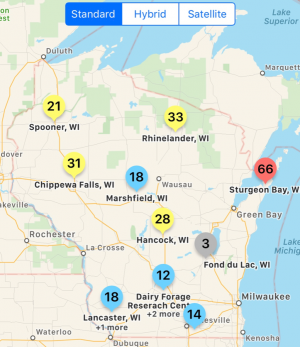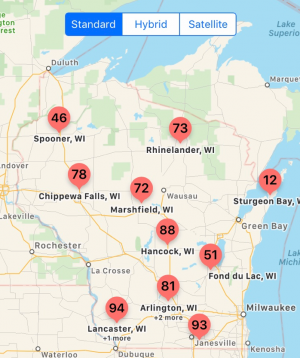
Damon Smith, Shawn Conley, & Roger Schmidt
Figure 1 illustrates the calculated risk of white mold for select Wisconsin locations for non-irrigated soybeans, as determined by Sporecaster for July 18, 2019. This means that if soybeans are flowering and the area between rows is filled in more than 50%, risk ranges from low to medium for the presence of apothecia and subsequent white mold development. Figure 2 illustrates calculated risk for the same locations for irrigated soybeans planted to 30-in row spacing. As you can imagine, risk is higher for irrigated soybeans planted to 15-in rows.

Extremely warm temperatures over the last week have pushed the risk down dramatically in non-irrigated fields. The UW Field Crops Pathology Team continues to scout white mold locations for apothecia. We have been unable to find apothecia at all locations we have visited over the last week.
I’m Ready To Spray, What Should I use?
If the canopy has met threshold, soybeans are flowering, and your Sporecaster risk is high, then a fungicide might be warranted. If you have decided to spray soybeans for white mold, what are the best products to use? Over the last several years we have run numerous fungicide efficacy trials in Wisconsin and in conjunction with researchers in other states. In Wisconsin, we have observed that Endura applied at 8 oz at the R1 growth stage performs well. We have also observed that the fungicide Aproach applied at 9 fl oz at R1 and again at R3 also performs comparably to the Endura treatment. Other fungicide options also include Omega and Proline. You can view results of past fungicide evaluations for Wisconsin by CLICKING HERE. If you would like to run tailored estimations of return on investment for various fungicide programs, you can use another smartphone application called Sporebuster.

The post Wisconsin Soybean White Mold Update – July 18, 2019 appeared first on Badger Crop Doc.